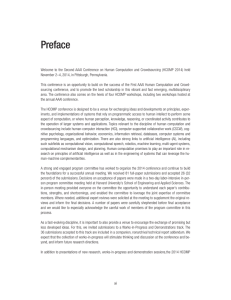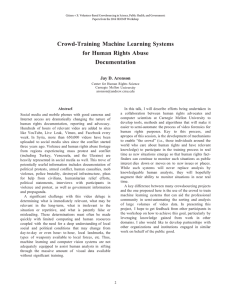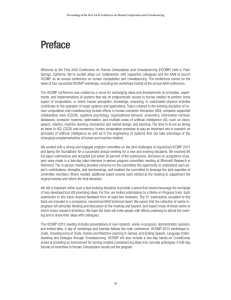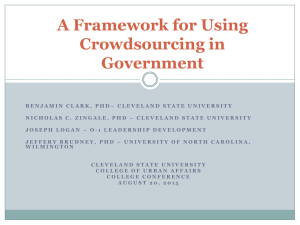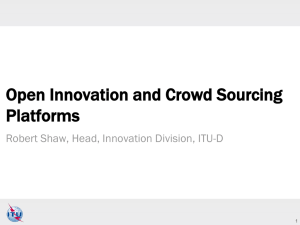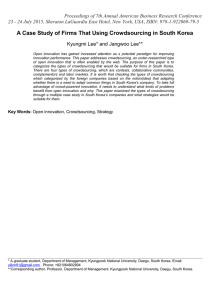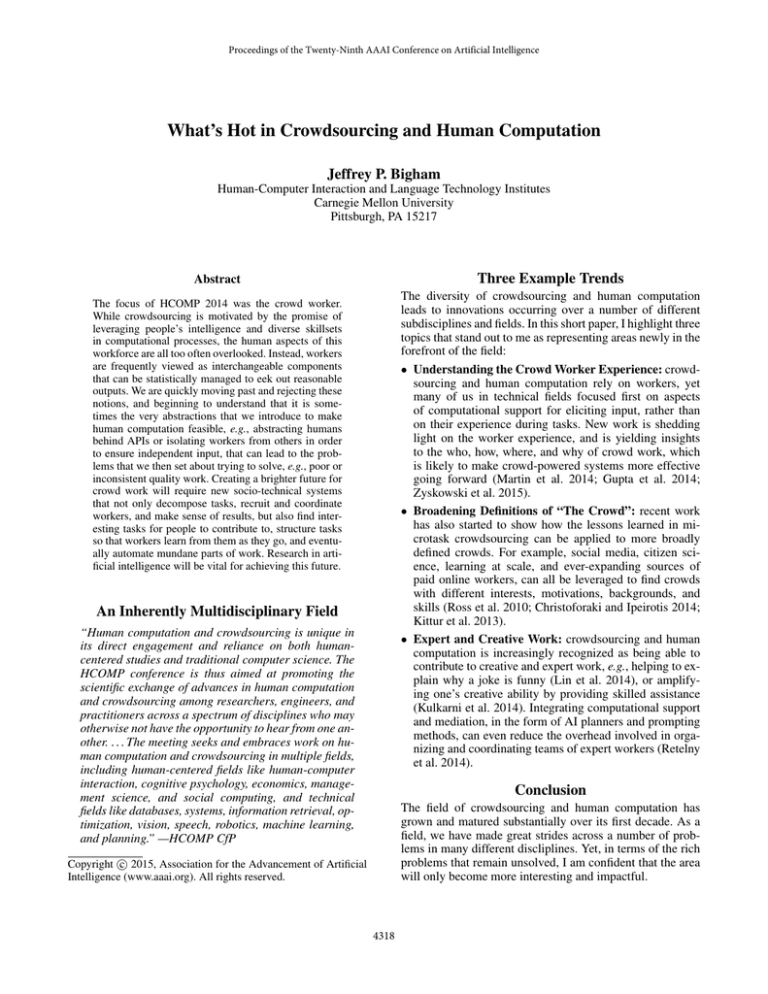
Proceedings of the Twenty-Ninth AAAI Conference on Artificial Intelligence
What’s Hot in Crowdsourcing and Human Computation
Jeffrey P. Bigham
Human-Computer Interaction and Language Technology Institutes
Carnegie Mellon University
Pittsburgh, PA 15217
Three Example Trends
Abstract
The diversity of crowdsourcing and human computation
leads to innovations occurring over a number of different
subdisciplines and fields. In this short paper, I highlight three
topics that stand out to me as representing areas newly in the
forefront of the field:
• Understanding the Crowd Worker Experience: crowdsourcing and human computation rely on workers, yet
many of us in technical fields focused first on aspects
of computational support for eliciting input, rather than
on their experience during tasks. New work is shedding
light on the worker experience, and is yielding insights
to the who, how, where, and why of crowd work, which
is likely to make crowd-powered systems more effective
going forward (Martin et al. 2014; Gupta et al. 2014;
Zyskowski et al. 2015).
• Broadening Definitions of “The Crowd”: recent work
has also started to show how the lessons learned in microtask crowdsourcing can be applied to more broadly
defined crowds. For example, social media, citizen science, learning at scale, and ever-expanding sources of
paid online workers, can all be leveraged to find crowds
with different interests, motivations, backgrounds, and
skills (Ross et al. 2010; Christoforaki and Ipeirotis 2014;
Kittur et al. 2013).
• Expert and Creative Work: crowdsourcing and human
computation is increasingly recognized as being able to
contribute to creative and expert work, e.g., helping to explain why a joke is funny (Lin et al. 2014), or amplifying one’s creative ability by providing skilled assistance
(Kulkarni et al. 2014). Integrating computational support
and mediation, in the form of AI planners and prompting
methods, can even reduce the overhead involved in organizing and coordinating teams of expert workers (Retelny
et al. 2014).
The focus of HCOMP 2014 was the crowd worker.
While crowdsourcing is motivated by the promise of
leveraging people’s intelligence and diverse skillsets
in computational processes, the human aspects of this
workforce are all too often overlooked. Instead, workers
are frequently viewed as interchangeable components
that can be statistically managed to eek out reasonable
outputs. We are quickly moving past and rejecting these
notions, and beginning to understand that it is sometimes the very abstractions that we introduce to make
human computation feasible, e.g., abstracting humans
behind APIs or isolating workers from others in order
to ensure independent input, that can lead to the problems that we then set about trying to solve, e.g., poor or
inconsistent quality work. Creating a brighter future for
crowd work will require new socio-technical systems
that not only decompose tasks, recruit and coordinate
workers, and make sense of results, but also find interesting tasks for people to contribute to, structure tasks
so that workers learn from them as they go, and eventually automate mundane parts of work. Research in artificial intelligence will be vital for achieving this future.
An Inherently Multidisciplinary Field
“Human computation and crowdsourcing is unique in
its direct engagement and reliance on both humancentered studies and traditional computer science. The
HCOMP conference is thus aimed at promoting the
scientific exchange of advances in human computation
and crowdsourcing among researchers, engineers, and
practitioners across a spectrum of disciplines who may
otherwise not have the opportunity to hear from one another. . . . The meeting seeks and embraces work on human computation and crowdsourcing in multiple fields,
including human-centered fields like human-computer
interaction, cognitive psychology, economics, management science, and social computing, and technical
fields like databases, systems, information retrieval, optimization, vision, speech, robotics, machine learning,
and planning.” —HCOMP CfP
Conclusion
The field of crowdsourcing and human computation has
grown and matured substantially over its first decade. As a
field, we have made great strides across a number of problems in many different discliplines. Yet, in terms of the rich
problems that remain unsolved, I am confident that the area
will only become more interesting and impactful.
c 2015, Association for the Advancement of Artificial
Copyright Intelligence (www.aaai.org). All rights reserved.
4318
Acknowledgments
A. Kulkarni, D. Rolnitzky, P. Narula, and N. Kontny. Wish:
Amplifying Creative Ability with Expert Crowds. HCOMP
2014.
C.-C. Lin, Y.-C. Huang, and J.-Y. Hsu. Crowdsourced Explanations for Humorous Internet Memes Based on Linguistic Theories. HCOMP 2014.
S. Retelny, S. Robaszkiewicz, A. To, W. S. Lasecki, J. Patel,
N. Rahmati, T. Doshi, M. Valentine, and M. S. Bernstein.
Expert crowdsourcing with flash teams. UIST 2014.
J. Ross, L. Irani, M. S. Silberman, A. Zaldivar, and B. Tomlinson. Who are the crowdworkers?. CHI 2010.
D. Martin, B. V. Hanrahan, J. O’Neill, and N. Gupta. 2014.
Being a Turker. CSCW 2014.
K. Zyskowski, M. R. Morris, J. P. Bigham, M. L. Gray and
S. Kane. 2015. Accessible Crowdwork? Understanding the
Value in and Challenge of Microtask Employment for People with Disabilities. CSCW 2015.
This work is the result of many great discussions, primarily
at the HCOMP 2014 conference in Pittsburgh, USA. The author of this paper is supported by Google, NSF Award #IIS1149709, and a Sloan Fellowship.
References
M. Christoforaki and P. Ipeirotis. STEP: A Scalable Testing
and Evaluation Platform. HCOMP 2014.
N. Gupta, D. Martin, B. V. Hanrahan, and J. ONeill. TurkLife in India. GROUP 2014.
A. Kittur, J. V. Nickerson, M. Bernstein, E. Gerber, A. Shaw,
J. Zimmerman, M. Lease, and J. Horton. The future of crowd
work. CSCW 2013.
4319


